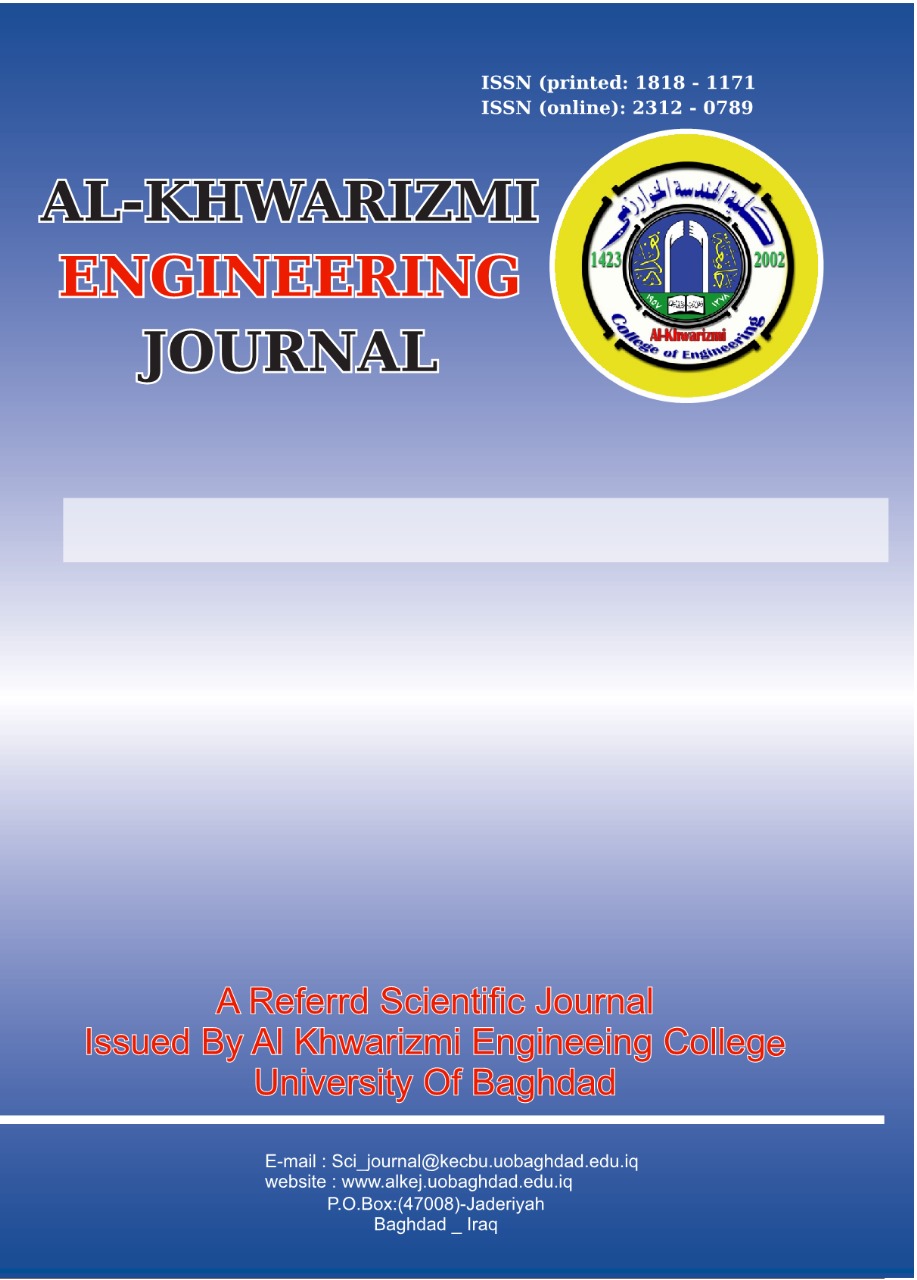Development of an ANN Model for RGB Color Classification using the Dataset Extracted from a Fabricated Colorimeter
DOI:
https://doi.org/10.22153/kej.2023.09.003Abstract
Codes of red, green, and blue data (RGB) extracted from a lab-fabricated colorimeter device were used to build a proposed classifier with the objective of classifying colors of objects based on defined categories of fundamental colors. Primary, secondary, and tertiary colors namely red, green, orange, yellow, pink, purple, blue, brown, grey, white, and black, were employed in machine learning (ML) by applying an artificial neural network (ANN) algorithm using Python. The classifier, which was based on the ANN algorithm, required a definition of the mentioned eleven colors in the form of RGB codes in order to acquire the capability of classification. The software's capacity to forecast the color of the code that belongs to an object under detection is one of the results of the proposed classifier. The work demanded the collection of about 5000 color codes which in turn were subjected to algorithms for training and testing. The open-source platform TensorFlow for ML and the open-source neural network library Keras were used to construct the algorithm for the study. The results showed an acceptable efficiency of the built classifier represented by an accuracy of 90% which can be considered applicable, especially after some improvements in the future to makes it more effective as a trusted colorimeter.
Downloads
References
J. Sainui and P. Pattanasatean, “Color Classification based on Pixel Intensity Values,” 2018 19th IEEE/ACIS International Conference on Software Engineering, Artificial Intelligence, Networking and Parallel/Distributed Computing (SNPD), Jun. 2018, doi: 10.1109/snpd.2018.8441141.
A. A. Soofi and A. M. Awan, “Classification techniques in Machine Learning: Applications and issues,” Journal of Basic and Applied Sciences, vol. 13, pp. 459–465, Jan. 2017, doi: 10.6000/1927-5129.2017.13.76.
S. Lassri, E. H. Benlahmar, and A. Tragha, “A review of Machine Learning Algorithms for web page Classification,” 2018 IEEE 5th International Congress on Information Science and Technology (CiSt), Oct. 2018, doi: 10.1109/cist.2018.8596420.
B. S. Kusumo, A. Heryana, O. Mahendra, and H. F. Pardede, “Machine Learning-based for Automatic Detection of Corn-Plant Diseases Using Image Processing,” 2018 International Conference on Computer, Control, Informatics and Its Applications (IC3INA), Nov. 2018, doi: 10.1109/ic3ina.2018.8629507.
S. K. Behera, L. Jena, A. K. Rath, and P. K. Sethy, “Disease Classification and Grading of Orange Using Machine Learning and Fuzzy Logic,” 2018 International Conference on Communication and Signal Processing (ICCSP), Apr. 2018, doi: 10.1109/iccsp.2018.8524415.
R. S. S. Kumari and V. Gomathy, “Fruit Classification using Statistical Features in SVM Classifier,” International Conference on Electrical Energy Systems (ICEES), Feb. 2018, doi: 10.1109/icees.2018.8442331.
K. P. Panigrahi, H. Das, A. K. Sahoo, and S. C. Moharana, “Maize leaf disease detection and classification using machine learning algorithms,” in Advances in intelligent systems and computing, 2020, pp. 659–669. doi: 10.1007/978-981-15-2414-1_66.
N. Hameed, A. M. Shabut, M. Ghosh, and M. A. Hossain, “Multi-class multi-level classification algorithm for skin lesions classification using machine learning techniques,” Expert Systems With Applications, vol. 141, p. 112961, Mar. 2020, doi: 10.1016/j.eswa.2019.112961.
T. Nagata, S. Noyori, H. Noguchi, G. Nakagami, A. Kitamura, and H. Sanada, “Skin tear classification using machine learning from digital RGB image,” Journal of Tissue Viability, vol. 30, no. 4, pp. 588–593, Nov. 2021, doi: 10.1016/j.jtv.2021.01.004.
A. Mary, Z. Bilal, and Z. Saad, “Face Recognition and Emotion Recognition from Facial Expression Using Deep Learning Neural Network,” ResearchGate, Nov. 2020, [Online]. Available: https://www.researchgate.net/publication/346007138_Face_Recognition_and_Emotion_Recognition_from_Facial_Expression_Using_Deep_Learning_Neural_Network
A. H. Mary, A. H. Miry, T. Kara, and M. H. Miry, “Nonlinear state feedback controller combined with RBF for nonlinear underactuated overhead crane system,” Journal of Engineering Research 9.3A (2021). https://doi.org/10.36909/jer.v9i3A.9159
E. Arce-Medina and J. I. Paz-Paredes, “Artificial neural network modeling techniques applied to the hydrodesulfurization process,” Mathematical and Computer Modelling, vol. 49, no. 1–2, pp. 207–214, Jan. 2009, doi: 10.1016/j.mcm.2008.05.010.
J. Maitre, K. Bouchard, and L. P. Bédard, “Mineral grains recognition using computer vision and machine learning,” Computers & Geosciences, vol. 130, pp. 84–93, Sep. 2019, doi: 10.1016/j.cageo.2019.05.009.
C. Kirankaya and L. G. Aykut, “Training of artificial neural networks with the multi-population based artifical bee colony algorithm,” Network: Computation in Neural Systems, vol. 33, no. 1–2, pp. 124–142, Apr. 2022, doi: 10.1080/0954898x.2022.2062472.
D. Hemavathi and H. Srimathi, “Retraction Note to: Effective feature selection technique in an integrated environment using enhanced principal component analysis,” Journal of Ambient Intelligence and Humanized Computing, vol. 14, no. S1, p. 535, Jun. 2022, doi: 10.1007/s12652-022-04239-4.
P. V. Chandrika and K. Srinivasan, “Predicting stock market movements using artificial neural networks,” Universal Journal of Accounting and Finance, vol. 9, no. 3, pp. 405–410, Jun. 2021, doi: 10.13189/ujaf.2021.090315.
J. Meiyazhagan, S. Sudharsan, A. Venkatasen, and M. Senthilvelan, “Prediction of occurrence of extreme events using machine learning,” European Physical Journal Plus, vol. 137, no. 1, Dec. 2021, doi: 10.1140/epjp/s13360-021-02249-3.
Downloads
Published
Issue
Section
License
Copyright: Open Access authors retain the copyrights of their papers, and all open access articles are distributed under the terms of the Creative Commons Attribution License, which permits unrestricted use, distribution, and reproduction in any medium, provided that the original work is properly cited. The use of general descriptive names, trade names, trademarks, and so forth in this publication, even if not specifically identified, does not imply that these names are not protected by the relevant laws and regulations. While the advice and information in this journal are believed to be true and accurate on the date of its going to press, neither the authors, the editors, nor the publisher can accept any legal responsibility for any errors or omissions that may be made. The publisher makes no warranty, express or implied, with respect to the material contained herein.
















